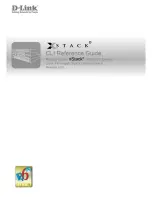
5000 Series Layer 2/3 Managed Data Center Switch CLI Reference Guide
838
interface.
T
A flag appended to an IPv6 route to indicate that it is an ECMP route,
but only one of its next hops has been installed in the forwarding table.
The forwarding table may limit the number of ECMP routes or the
number of ECMP groups. When an ECMP route cannot be installed
because such a limit is reached, the route is installed with a single next
hop. Such truncated routes are identified by a T after the interface
name.
In order to control the traffic destined for a particular network administratively and prevent the traffic from
being forwarded through a giv
en router, a static reject route can be configured on the router. The traffic
would then be discarded and an ICMP destination unreachable message would be sent back to the
source. This approach is typically utilized to prevent routing loops. The reject route that is added in the
recovery time object (RTO) will be
OSPF Inter-Area
types. Reject routes (REJECT route types installed
by any protocol) are not redistributed by OSPF and are supported in both OSPFv2 and OSPFv3.
8-45
show ipv6 route ecmp groups
Reports all the current ECMP groups included in the IPv6 routing table, where an ECMP group consists
of a set of two or more next hops that are used in one or more routes. Such groups are numbered in an
arbitrary manner from 1 to n. The output for the command indicates both the number of next hops in the
group as well as the number of routes that utilize the set of next hops. The output also includes the lPv6
address and the outgoing interface for each next hop in each group.
show ipv6 route ecmp-groups
Parameters
None
Default
The default is None.
Command Mode
Privileged EXEC
Example
The following is an example of the CLI display output for the command.
(router)#show ipv6 route ecmp-groups
ECMP Group 1 with 2 next hops (used by 1 route)
2001:DB8:1::1 on interface 2/1
2001:DB8:2::14 on interface 2/2
ECMP Group 2 with 3 next hops (used by 1 route)
2001:DB8:4::15 on interface 2/32
2001:DB8:7::12 on interface 2/33
2001:DB8:9::45 on interface 2/34
















































